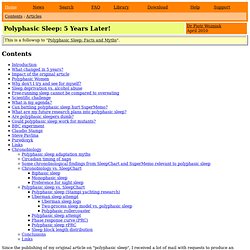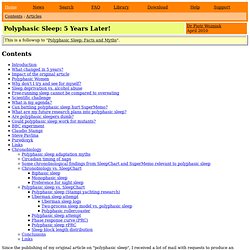

Polyphasic Sleep: 5 Years Later! Chronobiology Polyphasic sleep adaptation myths In my original article I tried to mix science with pop science, as well as with anecdote and humor.

Predictably, nearly all comments and criticism referred to the pop part, and no meaningful reply to the science argument landed in my Inbox. At the risk of having the science approach ignored entirely again, I hereby present a new angle at looking at the art of napping. Hopefully hard data collected with SleepChart and SuperMemo should back up the argument and add to its illustrative and explanatory power.
Have a peek at the following amazing picture obtained in recent months with the help of SuperMemo. Myth #1 of polyphasic adaptation: a nap is a nap is a nap. Myth #2 of polyphasic adaptation: the circadian cycle can be ignored or abolished, and the sleep can be reduced to one-dimensional homeostatic process. Circadian timing of naps Phase 5: Pre-siesta: napping in pre-siesta slot is possible. Phase 8: Siesta: perfect time for napping. Polyphasic Sleep: 5 Years Later! Chronobiology Polyphasic sleep adaptation myths In my original article I tried to mix science with pop science, as well as with anecdote and humor.

Predictably, nearly all comments and criticism referred to the pop part, and no meaningful reply to the science argument landed in my Inbox. At the risk of having the science approach ignored entirely again, I hereby present a new angle at looking at the art of napping. Hopefully hard data collected with SleepChart and SuperMemo should back up the argument and add to its illustrative and explanatory power. Have a peek at the following amazing picture obtained in recent months with the help of SuperMemo. Myth #1 of polyphasic adaptation: a nap is a nap is a nap. Myth #2 of polyphasic adaptation: the circadian cycle can be ignored or abolished, and the sleep can be reduced to one-dimensional homeostatic process. Claudio_Stampi_-_Why_We_Nap.pdf. Tomas-Votruba-Psychological-Impacts-of-Polyphasic-Sleep.pdf. This Guy Has Only Slept 4.5 Hours Per Day For Two Years. Courtesy of Eugene Dubovoy Eugene Dubovoy Eugene Dubovoy, a professional project manager based in Russia, has slept only four-and-a-half hours per day for the past two years and has no plans to stop.

"The biggest benefit is that I have about two months of extra time each year. Time is the most valuable resource in our lives," Dubovoy told Business Insider. Most people follow a monophasic sleep schedule, which involves seven to eight hours of continuous sleep every night. This compares to the average humans' monophasic sleep schedule, which involves four cycles of around 90 minutes total of non-rapid eye movement.
The science This graphic shows the various sleep stages in a normal monophasic schedule. As rationale for his sleep schedule, Dubovoy claims that early in the night, slow-wave sleep (stages three and four) occurs for the longest period, while in the morning, REM sleep takes over more of the cycle. Even Dubovoy wants those curious to proceed with caution, too. His transition. The Effects of Polyphasic and Ultrashort Sleep Schedules. Despite the considerable research conducted in the last three decades on relatively regular shift-work systems, the problems associated with unusual schedules, especially during conditions of intensive work, have received very limited attention.

But such quasi-continuous work situations are becoming increasingly common in industrialized societies. Some of these extended work scenarios involve performance of essential services in industries such as health care, transport, and nuclear electrical power, while others involve high-responsibility tasks in extreme situations, such as rescue operations, space missions, and defense efforts. In some situations the demands of continuous performance cannot easily be met simply by sharing work through conventional shift scheduling. In such situations of extreme demand the usual adult human monophasic sleep pattern (one 6–8 hr sleep episode per 24 hr) can rarely be maintained, resulting in an accumulated sleep debt. Polyphasic sleep strategies improve prolonged sustained performance: A field study on 99 sailors - Work & Stress - Volume 3, Issue 1. In situations where continuous prolonged work demands exist, the habitual nocturnal monophasic (6–8h duration) sleep pattern can rarely be accomplished, and performance effectiveness may sometimes be severely compromised by accumulation of sleep debt.

Several studies have shown that naps can be disproportionately effective in recovering functioning during continuous work (CW). In this study, sleep-wake patterns and their relationship to performance were studied for 99 sailors involved in solo and double-handed ocean sailing races (a model of a highly demanding CW situation). Most sailors spontaneously adopted multiple nap sleep-wake schedules and adapted without major difficulties to such polyphasic patterns. 66.5% had mean sleep episode durations (SEDs) ranging from 20 min to 2h.
Overall mean Total Sleep Time (TST) per 24h was reduced from a baseline of 7.5 to 6.3h. Race performance correlated negatively and significantly with mean SEDs and TSTs. Key Words Related articles. Journal of Cognitive Neuroscience.